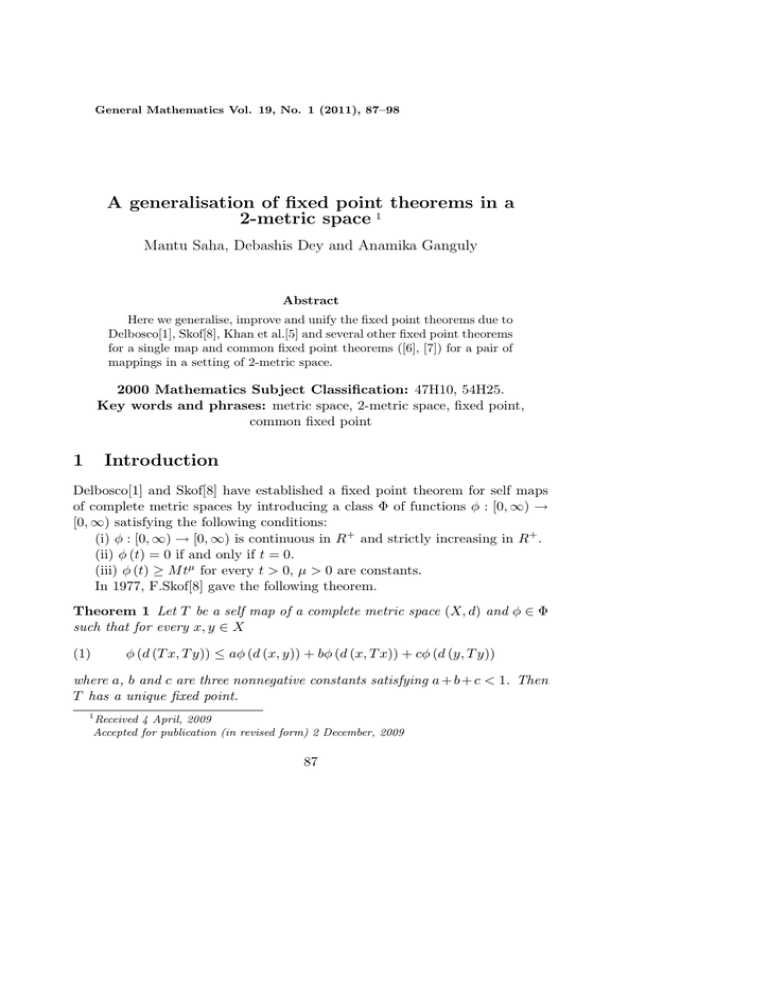A generalisation of fixed point theorems in a 2-metric space
advertisement

General Mathematics Vol. 19, No. 1 (2011), 87–98
A generalisation of fixed point theorems in a
2-metric space 1
Mantu Saha, Debashis Dey and Anamika Ganguly
Abstract
Here we generalise, improve and unify the fixed point theorems due to
Delbosco[1], Skof[8], Khan et al.[5] and several other fixed point theorems
for a single map and common fixed point theorems ([6], [7]) for a pair of
mappings in a setting of 2-metric space.
2000 Mathematics Subject Classification: 47H10, 54H25.
Key words and phrases: metric space, 2-metric space, fixed point,
common fixed point
1
Introduction
Delbosco[1] and Skof[8] have established a fixed point theorem for self maps
of complete metric spaces by introducing a class Φ of functions φ : [0, ∞) →
[0, ∞) satisfying the following conditions:
(i) φ : [0, ∞) → [0, ∞) is continuous in R+ and strictly increasing in R+ .
(ii) φ (t) = 0 if and only if t = 0.
(iii) φ (t) ≥ M tµ for every t > 0, µ > 0 are constants.
In 1977, F.Skof[8] gave the following theorem.
Theorem 1 Let T be a self map of a complete metric space (X, d) and φ ∈ Φ
such that for every x, y ∈ X
(1)
φ (d (T x, T y)) ≤ aφ (d (x, y)) + bφ (d (x, T x)) + cφ (d (y, T y))
where a, b and c are three nonnegative constants satisfying a + b + c < 1. Then
T has a unique fixed point.
1
Received 4 April, 2009
Accepted for publication (in revised form) 2 December, 2009
87
88
Mantu Saha, Debashis Dey and Anamika Ganguly
In 1984, Khan et al.[5] generalised the Theorem 1 by using much extensive
condition than (1) and removed the condition (iii). They proved the following
theorem as follows.
Theorem 2 Let T be a self map of a complete metric space (X, d) and φ
satisfying (i) and (ii). Furthermore , let a, b, c be three decreasing funtions
from R+ into [0, 1) such that a(t) + 2b(t) + c(t) < 1 for every t > 0. Suppose
T satisfies the folowing condition
φ (d (T x, T y)) ≤ a (d (x, y)) φ (d (x, y)) + b (d (x, y)) [φ (d (x, T x))
(2)
+φ (d (y, T y))] + c (d (x, y)) min {φ (d (x, T y)) ,
φ (d (x, T y))}
where x, y ∈ X and x 6= y. Then T has a unique fixed point.
We first give a 2-metric analogue of Theorem 2. In this connection we need
some preliminary ideas about 2-metric space.
2
Preliminaries
In Sixties, Gähler([2]-[3]) first defined 2-metric space as follows: Let X be a
non empty set. A real valued function d on X × X × X is said to be a 2-metric
on X if
(I) given distinct elements x,y of X, there exists an element z of X such that
d(x, y, z) 6= 0
(II) d(x, y, z) = 0 when at least two of x, y, z are equal,
(III) d(x, y, z) = d(x, z, y) = d(y, z, x) for all x, y, z in X, and
(IV) d(x, y, z) ≤ d(x, y, w) + d(x, w, z) + d(w, y, z) for all x, y, z, w in X.
When d is a 2-metric on X, then the ordered pair (X, d) is called a 2-metric
space.
Definition 1 A sequence {xn } in X is said to be a Cauchy sequence if for
each a ∈ X, lim d(xn , xm , a) = 0 as n, m → ∞.
Definition 2 A sequence {xn } in X is convergent to an element x ∈ X if for
each a ∈ X, lim d(xn , x, a) = 0
n→∞
Definition 3 A complete 2-metric space is one in which every Cauchy sequence in X converges to an element of X.
A generalisation of fixed point theorems ...
3
89
Main Results
Theorem 3 Let T be a self map of a complete 2-metric space (X, d) and φ
satisfying (i) and (ii). Furthermore , let a, b, c be three decreasing funtions
from R+ into [0, 1) such that a(t) + 2b(t) + c(t) < 1 for every t > 0. Suppose
T satisfies the folowing condition
φ (d (T x, T y, u)) ≤ a (d (x, y, u)) φ (d (x, y, u))
(3)
+b (d (x, y, u)) [φ (d (x, T x, u)) + φ (d (y, T y, u))]
+c (d (x, y, u)) min {φ (d (x, T y, u)) , φ (d (y, T x, u))}
where x, y, u ∈ X, each two of x, y and u are distinct. Then T has a unique
fixed point.
Proof. Let x0 ∈ X be arbitrary.
Define xn+1 = T xn ; n = 0, 1, 2, ..., also let αn = d (xn , xn+1 , u) for n =
0, 1, 2, ...; and βn = φ (αn ). Then we have
βn+1 = φ (αn+1 )
= φ (d (xn+1 , xn+2 , u))
= φ (d (T xn , T xn+1 , u))
≤ a (d (xn , xn+1 , u)) φ (d (xn , xn+1 , u))
+b (d (xn , xn+1 , u)) [φ (d (xn , T xn , u)) + φ (d (xn+1 , T xn+1 , u))]
+c (d (xn , xn+1 , u)) min {φ (d (xn , T xn+1 , u)) ,
φ (d (xn+1 , T xn , u))}
= a (d (xn , xn+1 , u)) φ (d (xn , xn+1 , u))
+b (d (xn , xn+1 , u)) [φ (d (xn , xn+1 , u)) + φ (d (xn+1 , xn+2 , u))]
+c (d (xn , xn+1 , u)) min {φ (d (xn , xn+2 , u)) , φ (d (xn+1 , xn+1 , u))}
= a (αn ) φ (αn ) + b (αn ) [φ (αn ) + φ (αn+1 )]
(4)
implies
Since a(t) + 2b(t) + c(t) < 1,
βn+1 ≤
a (αn ) + b (αn )
βn
1 − b (αn )
a (αn ) + 2b (αn ) < 1 which implies
a (αn ) + b (αn )
<1
1 − b (αn )
If we set
r=
a (αn ) + b (αn )
1 − b (αn )
90
Mantu Saha, Debashis Dey and Anamika Ganguly
then from (4) we get βn+1 ≤ rβn where r < 1. So βn ≤ rn β0 , such that
βn → 0 as n → ∞. Since βn < βn−1 and φ is strictly increasing, αn < αn−1 ,
n = 1, 2, ... Thus αn → α (say). Then βn = φ (αn ) → φ (α), since φ is
continuous. So φ (α) = 0 and hence by (ii), α = 0 implies αn → 0.
We now show that {xn } is a Cauchy sequence. We prove it by contradiction.
Then for every positive integer and for every positive integer k there exist
two positive integers m(k) and n(k) such that
(5)
k < n(k) < m(k) and d xm(k) , xn(k) , u > For each integer k, let m(k) be the least integer for which m(k) > n(k) > k,
d xn(k) , xm(k)−1 , u ≤ and d xn(k) , xm(k) , u > Then we have
< d xn(k) , xm(k) , u
(6)
≤ d xn(k) , xm(k) , xm(k)−1
+ d xn(k) , xm(k)−1 , u + d xm(k)−1 , xm(k) , u
Now by (3), we have
φ d xn(k) , xm(k) , xm(k)−1
= φ d T xn(k)−1 , T xm(k)−1 , xm(k)−1
≤ a d xn(k)−1 , xm(k)−1 , xm(k)−1
φ d xn(k)−1 , xm(k)−1 , xm(k)−1
+b d xn(k)−1 , xm(k)−1 , xm(k)−1
φ d xn(k)−1 , T xn(k)−1 , xm(k)−1
+φ d xm(k)−1 , T xm(k)−1 , xm(k)−1
+c d xn(k)−1 , xm(k)−1 , xm(k)−1
min φ d xn(k)−1 , T xm(k)−1 , xm(k)−1 ,
φ d xm(k)−1 , T xn(k)−1 , xm(k)−1
= a d xn(k)−1 , xm(k)−1 , xm(k)−1
φ d xn(k)−1 , xm(k)−1 , xm(k)−1
+b d xn(k)−1 , xm(k)−1 , xm(k)−1
φ d xn(k)−1 , xn(k) , xm(k)−1
+φ d xm(k)−1 , xm(k) , xm(k)−1
+c d xn(k)−1 , xm(k)−1 , xm(k)−1
min φ d xn(k)−1 , xm(k) , xm(k)−1 ,
φ d xm(k)−1 , xn(k) , xm(k)−1
= 0
A generalisation of fixed point theorems ...
91
which implies by (ii)
(7)
d xn(k) , xm(k) , xm(k)−1 = 0
So by (6) and (7) we get, < d xn(k) , xm(k) , u ≤ 0 + + αm(k)−1 . Since {αn }
converges to 0, d xn(k) , xm(k) , u → as k → ∞. Again
d xn(k)+1 , xm(k) , u ≤ d xn(k)+1 , xm(k) , xn(k) + d xn(k)+1 , xn(k) , u
+d xn(k) , xm(k) , u
= αn(k) + d xn(k) , xm(k) , u ,
since d xn(k)+1 , xm(k) ,xn(k) can be made 0 as we have done in equation (7).
So d xn(k)+1 , xm(k) , u ≤ αn(k) + d xn(k) , xm(k) , u → as k → ∞. In the
similar way
d xn(k)+2 , xm(k) , u ≤ d xn(k)+2 , xm(k) , xn(k)+1 + d xn(k)+2 , xn(k)+1 , u
+d xn(k)+1 , xm(k) , u
= αn(k)+1 + d xn(k)+1 , xm(k) , u ,
since d xn(k)+2 , xm(k) ,xn(k)+1 can be made 0 as we have
done in equation (7).
So d xn(k)+2 , xm(k) , u ≤ αn(k)+1 + d xn(k)+1 , xm(k)
,
u
→ as k → ∞ and in
similar fashion we can show d xn(k)+2 , xm(k)+1 , u → as k → ∞. Using (3),
92
Mantu Saha, Debashis Dey and Anamika Ganguly
we deduce that
φ d xn(k)+2 , xm(k)+1 , u
= φ d T xn(k)+1 , T xm(k) , u
≤ a d xn(k)+1 , xm(k) , u
φ d xn(k)+1 , xm(k) , u
+b d xn(k)+1 , xm(k) , u
φ d xn(k)+1 , T xn(k)+1 , u
+φ d xm(k) , T xm(k) , u
+c d xn(k)+1 , xm(k) , u
min φ d xn(k)+1 , T xm(k) , u ,
φ d xm(k) , T xn(k)+1 , u
= a d xn(k)+1 , xm(k) , u
φ d xn(k)+1 , xm(k) , u
+b d xn(k)+1 , xm(k) , u
φ d xn(k)+1 , xn(k)+2 , u
+φ d xm(k) , xm(k)+1 , u
+c d xn(k)+1 , xm(k) , u
min φ d xn(k)+1 , xm(k)+1 , u ,
φ d xm(k) , xn(k)+2 , u
Letting k → ∞, we get
φ () ≤ a () φ () + c () φ () = {a () + c ()} φ () < φ ()
which is a contradiction. So {xn } is a Cauchy sequence. Since X is complete
2-metric space, lim xn = z ∈ X. Now we shall show that T z = z.
n
Again using (3) we have
φ d xn(k)+1 , T z, u
= φ d T xn(k) , T z, u
≤ a d xn(k) , z, u φ d xn(k) , z, u
+b d xn(k) , z, u φ d xn(k) , T xn(k) , u
+φ (d (z, T z, u))] + c d xn(k) , z, u
min φ d xn(k) , T z, u , φ d z, T xn(k) , u
A generalisation of fixed point theorems ...
93
implies φ d xn(k)+1 , T z, u
≤ a d xn(k) , z, u φ d xn(k)+1 , z, u
+b d xn(k) , z, u
φ d xn(k) , xn(k)+1 , u
+φ (d (z, T z, u))]
+c d xn(k) , z, u
min φ d xn(k) , T z, u ,
φ d z, xn(k)+1 , u
Passing limit as n → ∞ on bothsides of the inequality we get,
φ (d (z, T z, u)) = 0 which gives by (ii), d (z, T z, u) = 0 i.e. T z = z. Next let w
be another fixed point of T . Then
φ (d (z, w, u)) = φ (d (T z, T w, u))
≤ a (d (z, w, u)) φ (d (z, w, u))
+b (d (z, w, u)) [φ (d (z, T z, u)) + φ (d (w, T w, u))]
+c (d (z, w, u)) min {φ (d (z, T w, u)) ,
φ (d (w, T z, u))}
= [a (d (z, w, u)) + c (d (z, w, u))] φ (d (z, w, u))
< φ (d (z, w, u)) ,
since a (t) + c (t) < 1
which is a contradiction leads to the fact that z = w and thus completes the
proof.
Next we verify the Theorem (3) by a proper example.
Example 1. Let X = R+ × R+ and d be a 2-metric which expresses d (x, y, u)
as the area of the Euclidean triangle with vertices x = (x1 , x2 ), y = (y1 , y2 )
and u = (u1 , u2 ). Then (X, d) is a complete 2-metric space[6].
Now take x = (1, 0), y = (2, 0) and u = (1, 1) also let T : X → X be a
mapping such that
T x = (2, 0) where x = (1, 0) ∈ X and
T y = (3, 0) where y = (2, 0) ∈ X
Now setting a(t) = 25 , b(t) = 51 , c(t) = 16 and φ (t) = t2 ; t ∈ R+ . We observe
that all the conditions of Theorem (3) satisfied except the condition (3). Also
it is very clear that T has no fixed point in X in this case.
Next we establish a common fixed point theorem in this line.
Theorem 4 Let S and T be self mappings of a complete 2-metric space (X, d)
and φ satisfying (i) and (ii). Furthermore , let a, b, c be three decreasing
94
Mantu Saha, Debashis Dey and Anamika Ganguly
funtions from R+ into [0, 1) such that a(t) + 2b(t) + c(t) < 1 for every t > 0.
Suppose S and T satisfy the folowing condition
φ (d (Sx, T y, u)) ≤ a (d (x, y, u)) φ (d (x, y, u))
(8)
+b (d (x, y, u)) [φ (d (x, Sx, u)) + φ (d (y, T y, u))]
+c (d (x, y, u)) min {φ (d (x, T y, u)) ,
φ (d (y, Sx, u))}
where x, y, u ∈ X, each two of x, y and u are distinct. Then S and T have a
unique common fixed point in X.
Proof. Let x0 ∈ X be arbitrary. Define x2n = Sx2n−1 and x2n+1 = T x2n ;
n = 0, 1, 2, ..., also let αn = d (xn , xn+1 , u) for n = 0, 1, 2, ...; and βn = φ (αn ).
We also assume that αn > 0 for every n. Now for an even integer n, we have
βn = φ (αn )
= φ (d (xn , xn+1 , u))
= φ (d (Sxn−1 , T xn , u))
≤ a (d (xn−1 , xn , u)) φ (d (xn−1 , xn , u))
+b (d (xn−1 , xn , u)) [φ (d (xn−1 , Sxn−1 , u)) + φ (d (xn , T xn , u))]
+c (d (xn−1 , xn , u)) min {φ (d (xn−1 , T xn , u)) , φ (d (xn , Sxn−1 , u))}
= a (d (xn−1 , xn , u)) φ (d (xn−1 , xn , u))
+b (d (xn−1 , xn , u)) [φ (d (xn−1 , xn , u)) + φ (d (xn , xn+1 , u))]
+c (d (xn−1 , xn , u)) min {φ (d (xn−1 , xn+1 , u)) , φ (d (xn , xn , u))}
= a (αn−1 ) φ (αn−1 ) + b (αn−1 ) [φ (αn−1 ) + φ (αn )]
(9)
implies
βn ≤
Since a(t) + 2b(t) + c(t) < 1,
a (αn−1 ) + b (αn−1 )
βn−1
1 − b (αn−1 )
a (αn−1 ) + 2b (αn−1 ) < 1 which implies
a (αn−1 ) + b (αn−1 )
<1
1 − b (αn−1 )
If we set
r=
a (αn−1 ) + b (αn−1 )
1 − b (αn−1 )
then from (3.9) we get βn ≤ rβn−1 where r < 1. So βn ≤ rn β0 , such that
βn → 0 as n → ∞. Since βn < βn−1 and φ is strictly increasing, αn < αn−1 ,
A generalisation of fixed point theorems ...
95
n = 1, 2, ... Thus αn → α (say). Then βn = φ (αn ) → φ (α), since φ is
continuous. So φ (α) = 0 and hence by (ii), α = 0 implies αn → 0.
We now show that {xn } is a Cauchy sequence. We prove it by contradiction.
Then for every positive integer and for every positive integer k there exist
two positive integers 2p(k) and 2q(k) such that
(10)
k < 2q(k) < 2p(k) and d x2p(k) , x2q(k) , u > For each integer k, let 2p(k) be the least integer for which 2p(k) > 2q(k) > k,
d x2q(k) , x2p(k)−2 , u ≤ and d x2q(k) , x2p(k) , u > Then we have
< d x2q(k) , x2p(k) , u ≤ d x2q(k) , x2p(k) , x2p(k)−2 + d x2q(k) , x2p(k)−2 , u
+d x2p(k)−2 , x2p(k) , u
Since we can easily show that d x2q(k) , x2p(k) , x2p(k)−2 = 0 as we have shown
in equation (7) of Theorem (3).
< d x2q(k) , x2p(k) , u ≤ d x2q(k) , x2p(k)−2 , u + d x2p(k)−2 , x2p(k) , u
≤ d x2q(k) , x2p(k)−2 , u
+d x2p(k)−2 , x2p(k) , x2p(k)−1
+d x2p(k)−2 , x2p(k)−1 , u + d x2p(k)−1 , x2p(k) , u
Again we can show like equation
(7) of Theorem (3),
d x2p(k)−2 , x2p(k) , x2p(k)−1 = 0. Thus
(11)
< d x2q(k) , x2p(k) , u ≤ + 0 + α2p(k)−2 + α2p(k)−1
Since {αn } converges to 0, d x2q(k) , x2p(k) , u → .
Now d x2q(k) , x2p(k)+1 , u ≤ d x2q(k) , x2p(k)+1 , x2p(k)
+d x2q(k) , x2p(k) , u
+d x2p(k) , x2p(k)+1 , u
≤ d x2q(k) , x2p(k) , u + α2p(k)
since we can show that d x2q(k) , x2p(k)+1 , x2p(k) = 0 as we have done in equation (7) of Theorem (3).
(12)
So d x2q(k) , x2p(k)+1 , u → as k → ∞
96
Mantu Saha, Debashis Dey and Anamika Ganguly
Again
d x2q(k) , x2p(k)+2 , u ≤ d x2q(k) , x2p(k)+2 , x2p(k)+1 + d x2q(k) , x2p(k)+1 , u
+d x2p(k)+1 , x2p(k)+2 , u
≤ d x2q(k) , x2p(k)+1 , u + d x2p(k)+1 , x2p(k)+2 , u ,
since d x2q(k) , x2p(k)+2 , x2p(k)+1 = 0 for similar
reason as of equation (7) of Theorem (3)
≤ d x2q(k) , x2p(k)+1 , x2p(k) + d x2q(k) , x2p(k) , u
+d x2p(k) , x2p(k)+1 , u + d x2p(k)+1 , x2p(k)+2 , u
≤ 0 + d x2q(k) , x2p(k) , u + α2p(k) + α2p(k)+1
which gives
(13)
(14)
d x2q(k) , x2p(k)+2 , u → as k → ∞
Similarly, d x2q(k)+1 , x2p(k)+2 , u → as k → ∞
Now from (8) we get
φ d x2p(k)+2 , x2q(k)+1 , u
= φ d Sx2p(k+)1 , T x2q(k) , u
≤ a d x2p(k)+1 , x2q(k) , u
φ d x2p(k)+1 , x2q(k) , u
+b d x2p(k)+1 , x2q(k) , u
φ d x2p(k)+1 , Sx2p(k)+1 , u
+φ d x2q(k) , T x2q(k) , u
+c d x2p(k)+1 , x2q(k) , u
min φ d x2p(k)+1 , T x2q(k) , u ,
φ d x2q(k) , Sx2p(k)+1 , u
Passing limit as k → ∞ we get by (12), (13) and (14),
φ () ≤ a () φ () + c () φ () = {a () + c ()} φ () < φ ()
A generalisation of fixed point theorems ...
97
which is a contradiction. So {xn } is a Cauchy sequence. Since X is complete
2-metric space, lim xn = z ∈ X. Again using (8) we have
n
φ d x2p(k)+2 , T z, u
= φ d Sx2p(k)+1 , T z, u
≤ a d x2p(k)+1 , z, u φ d x2p(k)+1 , z, u
+b d x2p(k)+1 , z, u
φ d x2p(k)+1 , Sx2p(k)+1 , u
+φ (d (z, T z, u))] + c d x2p(k)+1 , z, u
min φ d x2p(k)+1 , T z, u ,
φ d z, Sx2p(k)+1 , u
Taking limit as k → ∞ we get φ (d (z, T z, u)) = 0 implies d (z, T z, u) = 0 by
property (ii). Hence T z = z. Similarly it can be shown that Sz = z. So S
and T have a common fixed point z ∈ X. We now show that z is the unique
common fixed point of S and T . If not, then let w be another fixed point of
S and T . Then
φ (d (z, w, u)) = φ (d (Sz, T w, u))
≤ a (d (z, w, u)) φ (d (z, w, u))
+b (d (z, w, u)) [φ (d (z, Sz, u)) + φ (d (w, T w, u))]
+c (d (z, w, u)) min {φ (d (z, T w, u)) ,
φ (d (w, Sz, u))}
= [a (d (z, w, u)) + c (d (z, w, u))] φ (d (z, w, u))
< φ (d (z, w, u)) ,
since a (t) + c (t) < 1
which is a contradiction. Hence z = w and thus completes the proof.
Remark 1. In the same way we can verify the Theorem (4) by setting
S(1, 0) = (2, 0) and T (2, 0) = (3, 0) taking all the values same on the complete
2-metric space (X, d) as described in Example 1.
References
[1] D. Delbosco, Un estensione di un teorema sul punto fisso di S.Reich,
Rend. Sem. Mat. Univers. Politecn. Torino , 35(1976-77), 233 - 239.
[2] S.Gähler, 2-metric Raume and ihre topologische strucktur,
Math.Nachr., 26(1963), 115-148.
98
Mantu Saha, Debashis Dey and Anamika Ganguly
[3] S.Gähler, Uber die unifromisieberkeit 2-metrischer Raume,
Math.Nachr. 28(1965), 235 - 244.
[4] K.Iseki, Fixed point theorems in 2-metric space , Math.Seminar.Notes,
Kobe Univ.,3(19765), 133 - 136.
[5] M.S.Khan, Fixed point theorems by altering distance between the points ,
Bull. Austral. Math. Soc. , 30 (1984), 1 - 9.
[6] Z. Liu, F. Zhang and J. Mao, Common Fixed Points for Compatible Mappings of Type (A), Bull. Malaysian Math. Soc.(Second Series) 22 (1999),
67 - 86.
[7] R.A. Rashwan andA.M.Sadeek, A common fixed point theorem in complete metric spaces, Southwest journal of pure and applied mathematics,
01(1996), 6 - 10.
[8] F.Skof , Teorema di punti fisso per applicazioni negli spazi meirici , Atti.
Accad. Aci. Torino, 111 (1977), 323-329.
Mantu Saha
The University of Burdwan
Department of Mathematics
Burdwan-713104, West Bengal, India
e-mail: mantusaha@yahoo.com
Debahis Dey
Koshigram Union Institution,
Koshigram-713150, Burdwan,
West Bengal, India,
e-mail: debashisdey@yahoo.com
Anamika Ganguly
Balgona Saradamoni Balika Vidyalaya,
Balgona Station and Chati,
P.O. Bhatar, Dist. Burdwan, West Bengal India,
e-mail: anamika.simi@gmail.com





